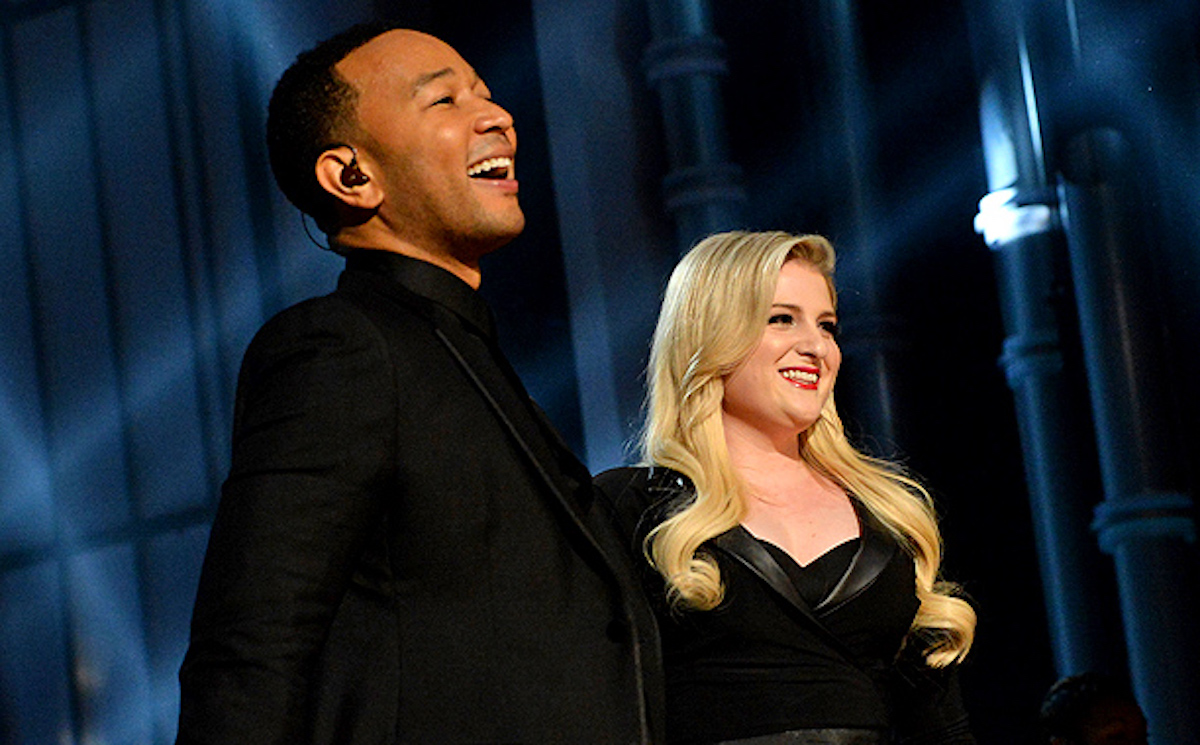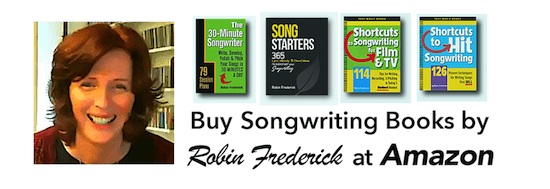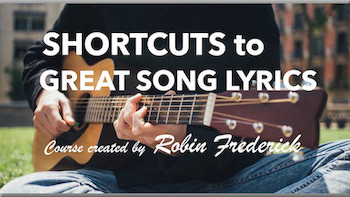
Question: How do you follow up a platinum, career-launching single like Meghan Trainor’s “All About That Bass”? Answer: With two more relentlessly catchy songs that build on a similar retro-blend sound.
Which is exactly what Meghan Trainor did. But after the third single – as much fluffy fun as it was – listeners were bound to wonder if things weren’t starting to sound a little same-y. Time for something new. Trainor hit the sweet spot with a ballad/duet with John Legend that slides perfectly into Trainor’s throwback sound while revealing more emotional depth.
TECHNIQUES TO HEAR AND TRY:
• Blend vintage and contemporary song elements.
• Maintain a tight lyric focus on your theme.
• Make your melody memorable by using patterns.
Recorded by Megan Trainor and John Legend
Songriters: Meghan Trainor, Justin Weaver, Caitlyn Smith
GENRE/STYLE
This is a great example of a retro-blend song that drops neatly into today’s Adult Contemporary/Pop genre. Producer Chris Gelbuda calls the overall album style “Doo-Wop/Pop Throwback” and references “Stand By Me” by Ben E. King as an influence on this particular song. I’m reminded of classic Marvin Gaye/Tammi Terrell duets like “Your Precious Love” and “You’re All I Need to Get By.” From the moment John Legend enters on Verse 2, there are references this classic duet sound.
Underlying all this rich, vintage Soul is a poetically modern lyric, an unusual lyric theme, a loop-style rhythm track, and a punchy, dry mix. All of which give this song a contemporary edge.
SONG STRUCTURE
Here’s the way I hear the song structure of “Like I’m Gonna Lose You.”
VERSE 1 / PRE-CHORUS 1 / CHORUS
VERSE 2 / PRE-CHORUS 2 / CHORUS
INSTRUMENTAL VERSE
FINAL CHORUS
VERSES: The first verse opens with “I found myself dreaming/In silver and gold.” The second verse starts with “In the blink of an eye/Just a whisper of smoke.”
PRE-CHORUSES: The first pre-chorus begins with the line “I woke up in tears with you by my side…” The second pre-chorus opening line is “Let’s take our time to say what we want.”
CHORUS: The chorus starts with title of the song included in a complete phrase: “So I’m gonna love you like I’m gonna lose you.“ Extending a short title into a longer phrase is a great way to start or end your chorus… or both.
INTRO: Talk about a short intro! There’s a quick guitar pickup on Beat 4, then the singer pops right in. When arranging a slow ballad, consider keeping your intro short and bringing the singer in right away. You’ll give the listener plenty of reasons to get involved right from the top: a lyric, melody, and vocal.
– Try It Now –
Watch the video or listen to the song “Like I’m Gonna Lose You” and identify each song section. Then listen to a few classic Doo-Wop songs or check out some of the great Motown Soul-Pop duets by Marvin Gaye and Tammi Terrell to hear how the structures are similar and how they’re different from today. Choose a song structure from one of these classic hits and write a rough verse and chorus to get the feel.
LYRICS
KEY LINES: The “key lines” are the lyric lines that listeners tend to hear and remember. The first and last lines of the chorus and the first lines of each verse are the key lines. Try to express your lyric theme in those lines in ways that are intriguing, that make the listener want to hear more. In this song, the key lines are:
“I found myself dreaming/In silver and gold.”
“In the blink of an eye / Just a whisper of smoke.”
“So I’m gonna love you like I’m gonna lose you.“
Each of these lines suggests something tantalizing for listeners. A dream “in silver and gold” must be really beautiful, so perhaps they’ll stick around to hear more. What happens in the “blink of an eye” or a “whisper of smoke”? Why is the singer going to love as if she’s going to lose someone? Creating an inviting image or intriguing question in your key lines is a good way to draw listeners into your song and keep them there.
MAINTAIN LYRIC FOCUS: The song “Like I’m Gonna Lose You” is a great example of tight lyric focus. One of the big mistakes we all make from time to time is trying to say too much in a song. Listeners will get more involved in your lyric if you stick to a single idea and go deeper into it. There isn’t a lot of lyric “real estate” in a song, just a repeated chorus, two verses, and maybe a bridge section. Use every bit of it to tell listeners about your core idea.
In this song, the chorus lays out the central idea in the very first line (“I’m gonna love you like I’m gonna lose you”) and repeats it twice at the end. That’s a lot of repetition by the time this song is over, so the writers need to make sure the listener has enough information to make it meaningful…
Why is the singer saying this?
Why is it important enough to care about?
What is the singer willing to do about it?
Answering these three questions can keep almost any lyric tightly focused on a theme. Here’s how these songwriters did it:
▪ Why is the singer saying this?
▪ She dreamed her lover was gone and realized “we’re not promised tomorrow.”
▪ Why is it important enough to care about?
▪ She could “lose everything” in an instant.
▪ What is the singer willing to do about it?
▪ She will “kiss you longer” “make the most of the minutes and love with no regrets.”
If you’re stuck on a song lyric and don’t know what to write, ask yourself what you really want to say. When you know what it is, ask yourself why it’s important enough to write a song about it. Then, make a list of things the singer has tried to do about it or is willing to do about it. If that doesn’t give you enough to write about, ask yourself what you think listeners need to know in order to feel what the singer feels.
Here’s a blog post that will give you more ideas on how to keep your lyric tightly focused and moving forward. What Are You Really Writing About?
– Try It Now –
Take a look at the lyric you roughed out in the Structure section above. See if you can complete it by answering basic questions about the central idea. Try answering the same questions as this song does, or vary the questions to fit your theme. You could even try the “dream” idea used in Verse 1. This isn’t the first song to do it, and it won’t be the last.
MELODY & CHORDS
The song has a relaxed, laid back feel and a tempo to match. At 72 BPM, the song risks being too slow to keep listeners interested. To make things even more challenging, this is one of those four-chord songs with a chord pattern that simply repeats over and over:
C, Em, Am, F. That’s it, folks.
KEEP A SLOW MELODY MOVING FORWARD: To create a sense of motion and energy the writers allow only brief pauses (usually about one beat) between lines. Print out the lyrics and sing along with this melody. Notice that in the verse and chorus you have just enough time to comfortably take a breath between lines. When one line ends, the next picks up. The listener gets the feeling of being carried along by the constant motion of the melody. Only the pre-chorus has a slightly different pattern with a longer pause after “and I realized…”
VARY THE LENGTH & RHYTHM OF MELODY PHRASES: Melody patterns are a great way to keep your melody interesting and easy to remember. Notice how Verse 1 creates a pattern of two short lines, then a long one.
I found myself dreaming
In silver and gold
Like a scene from a movie that every broken heart knows.
We were walking on moonlight
And you pulled me close
Split second and you disappeared and then I was all alone
This is a pattern that you hear in many hit songs. Listeners like it because there’s enough repetition to make it easy to recall and enough variation to keep it interesting.
The chorus features a different kind of pattern, a repeated pattern of long and short notes. Each phrase begins with a little bunch of short notes (“so I’m gonna…” “Like I’m gonna…”) and ends with two long notes (“love you” “lose you” “hold you”). The fourth line creates a variation by holding out the last syllable (“goodbye”). Then the whole pattern repeats with the same melody but different lyrics. Then it repeats again in a lower notes range (So, I’m gonna love you…” etc.). Talk about easy to remember!
You don’t need to worry about things like melodic phrasing and repetition when you’re writing the first draft of a song. But once you have a rough idea of your song melody, go through it and look for opportunities to create a pattern of phrase lengths or repeat a pattern of long and short notes.
VARY THE MELODY IN VERSE 2: With so much repetition going on, I think John Legend made the right choice when he comes in on Verse 2. He changes up the verse melody to give the listener something new while still maintaining the identity of the verse. More motion in the notes and a few higher pitches lift the second verse and give it extra energy. This is a common technique in the R&B genre, not so much in Pop.
– Try It Now –
In a song of your own, look for patterns of phrase lengths and patterns of long and short notes. If your melody patterns are too repetitive, or not repetitive enough, try some of the techniques used in this song to give a clearer shape to your melody and add memorability.
For slow to mid-tempo songs, try filling in some of the line-ending pauses by lengthening a line or starting the next line a little earlier.
PRODUCTION
If you’ve got a song with a vintage feel and want to give it a contemporary edge, this unusual arrangement and mix are well worth “stealing” from. Acoustic guitar, loop-style drums, and vocals carry the entire first verse and pre-chorus. Then an interesting thing happens: an organ swell kicks off the chorus, then disappears. It’s gone. (Don’t worry. It comes back later.) A bass is added and more of the drum kit but that’s all. About half way through the chorus there’s a single sax lick way in the background. Finally, a piano enters playing a classic straight eighth-note rhythm pattern on the last two lines of the chorus. Then it, too, drops out and we’re back to acoustic guitar for verse 2.
While organ, sax, and piano are classic instruments in this style, they come and go in unusual ways and aren’t featured. Needless to say, finger-picked acoustic guitar was not a featured instrument in most Doo-Wop and R&B recordings.
In other words, even though there are some throwback instruments, this recording is definitely not attempting to recreate a vintage arrangement or mix. If you’re looking to steal a few creative ideas for arranging and mixing a retro-blend record, I highly recommend a careful listen on headphones.
– Try It Now –
If you think you might like to write a song in a throwback stye like this, learn to play and sing this hit. Get it in your hands. Embed it. Here are the lyrics and chords to this song. Then adapt the melody and lyric writing techniques in this hit song to your own style.
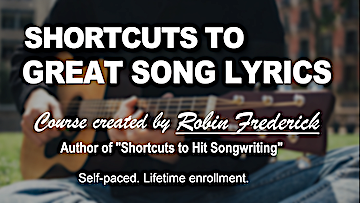
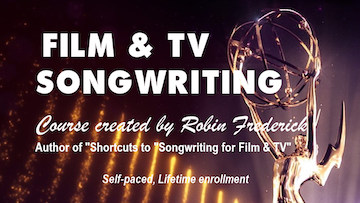
EXTRA READING: To find out more about the techniques used in “Like I’m Gonna Love You” read the following…
In Shortcuts to Hit Songwriting:
Shortcut 3: Learn From the Hits: Don’t Reinvent the Wheel
Shortcut 44: Answer the Questions the Title Asks
Shortcut 56: “Key Lines”: The Lyric Lines They Always Hear
Shortcut 88: Melodic Rhythm Patterns: The Key to Catchy Melodies
In Shortcuts to Songwriting for Film & TV:
Shortcut 32: Expand an Anchor Phrase Into a Memorable Melody
Shortcut 69: The Best Advice: Train Your Ears
Shortcut 74: Arranging: Use Similar Artists or a Genre as a Guide
